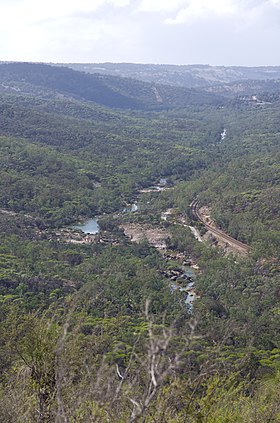Avon River (Western Australia)
| Avon | |
|---|---|
 Avon River flowing through the Avon Valley National Park | |
 Location of the Avon River and its catchment area | |
| Location | |
| Country | Australia |
| State | Western Australia |
| Region | Wheatbelt |
| Physical characteristics | |
| Source | surface runoff |
| • location | East of Pingelly |
| • coordinates | 32°44′52″S 117°28′0″E / 32.74778°S 117.46667°E |
| • elevation | 269 m (883 ft) |
| Mouth | confluence with Wooroloo Brook to form the Swan River |
• location | below Mount Mambup |
• coordinates | 31°44′34″S 116°4′4″E / 31.74278°S 116.06778°E |
• elevation | 29 m (95 ft) |
| Length | 240 km (150 mi) |
| Basin size | 125,000 km2 (48,000 sq mi) |
| Discharge | |
| • location | mouth |
| • average | 10 m3/s (350 cu ft/s) |
| Basin features | |
| River system | Swan River |
| Tributaries | |
| • left | Dale River |
| • right | Mackie River, Mortlock River, Brockman River |
| National park | Avon Valley National Park |
The Avon River is a river in Western Australia. A tributary of the Swan River, the Avon flows 240 kilometres (150 mi)[1] from source to mouth, with a catchment area of 125,000 square kilometres (48,000 sq mi).[2]
Avon catchment area
Lake Yealering in the Shire of Wickepin is the point of origin for the upper Avon River, and the catchment size above the confluence with the Salt River at Yenyening Lakes is 91,500 square kilometres (35,300 sq mi).[3]
The basin covers much of the Western Australian wheatbelt[4] and extends beyond that in some areas near almost-always-dry Lake Moore in the northeast, water is received regularly from only the extreme western edge of the basin. Indeed, until an abnormally wet year in 1963 it was not realised that the northeastern part of the basin beyond Wongan Hills ever drained water into the river. Under present climatic conditions, it is almost impossible to produce runoff from anywhere outside the extreme west of the basin because the amount of rain required to fall before runoff would begin is as high or higher than the mean annual rainfall. The river has three main sub-catchments: catchments for the Mortlock, Yilgarn, and Lockhart rivers.
The river flows past County Peak, creating a picturesque view from the top.[5][6]
Course and features
Thirty creeks and rivers flow into the Avon; some of the larger tributaries include the Dale River, Brockman River, Mortlock River and the Mackie River.[1] Most of these watercourses are ephemeral and only flow after rain in winter and spring.
Some permanent pools exist along the course of the river including Burlong Pool, Robins Pool, Long Pool, Cobblers Pool and Jimperding Pool.
The Avon River Valley is the third and final route for the Eastern Railway line through the Darling Scarp between Midland and Northam, having been constructed in the 1960s.
It is the site of an annual whitewater boating event, the Avon Descent.
Soils
Due to the extraordinary age of the soils in the basin (which is on the extremely ancient Yilgarn Craton), the rooting density of native flora is very high and its average specific discharge is probably the lowest of any basin of comparable size in the world. The extreme age of the soils also means that, at least after clearing for agriculture, almost all rivers in the basin have salinities above 0.3% (one-tenth that of the oceans and eight times that necessary to qualify as "fresh" water) and some much more than that.
Passing through some of the oldest settled European agricultural areas in Western Australia, the catchment area has extensive soil salinity issues, which have attracted governmental programmes to alleviate the loss of agricultural lands. Catchment groups that oversee projects in the tributary parts of the river have had considerable support and funding from commercial and non-governmental sources as well.
See also
References
- ^ a b "Map of Avon River, WA". Bonzle Digital Atlas of Australia. 2011. Retrieved 17 September 2011.
- ^ "The Swan-Avon Catchments". Describing the Swan River. State Library of Western Australia. 23 November 2010.
- ^ "Avon Region - Wheatbelt Natural Resource Management - Leading natural resource management (NRM) endeavours - Avon River Basin". Archived from the original on 19 February 2011. Retrieved 2010-11-28.
- ^ Western Australia.(2008) Dept. of Water. Managing waterways in the Avon wheatbelt: field guide Perth, W.A. Dept. of Water – "This is an Avon Catchment Council project delivered by the Department of Water and funded with investment from the state and Australian governments through the Natural Heritage Trust and the National Action Plan for Salinity and Water Quality." "June 2008" http://henrietta.liswa.wa.gov.au/record=b2561801~S2 Archived 8 March 2012 at the Wayback Machine – Also available as an electronic version via the Internet. ISBN 978-1-921468-75-9
- ^ "Natural attractions in Beverley". Beverley, WA. Retrieved 19 April 2018.
- ^ "Tourist Road at County Peak". The Beverley Times. Vol. 62, no. 22. Western Australia. 10 June 1966. p. 1. Retrieved 23 October 2017 – via National Library of Australia.
Further reading
- Harris, T. F. W. (1996) The Avon : an introduction Perth, W.A.: Water and Rivers Commission ISBN 0-7309-6989-4
External links
- http://www.wheatbeltnrm.org.au/ – formerly the Avon Catchment Council – known now as the Wheatbelt Natural Resource Management Inc.